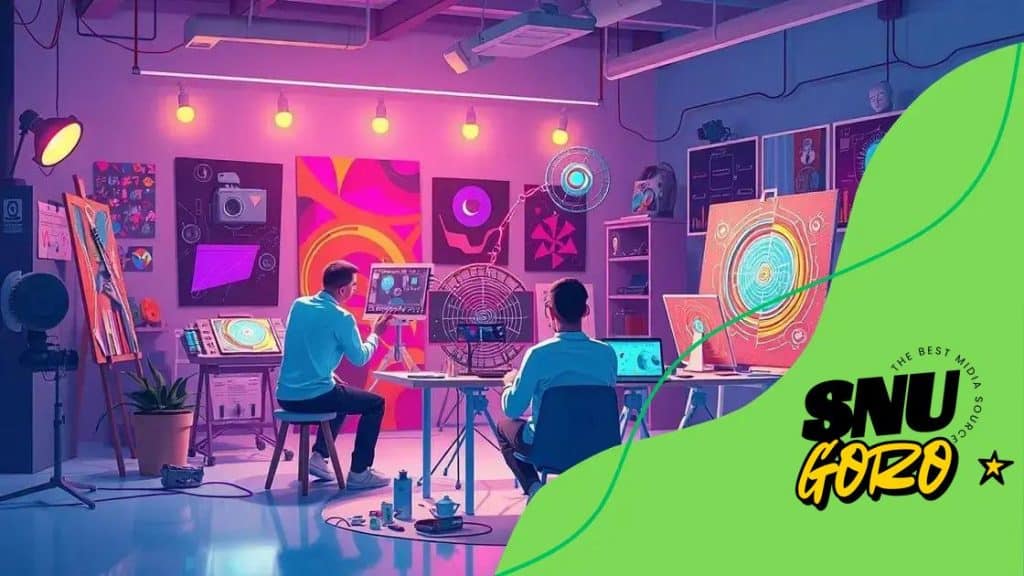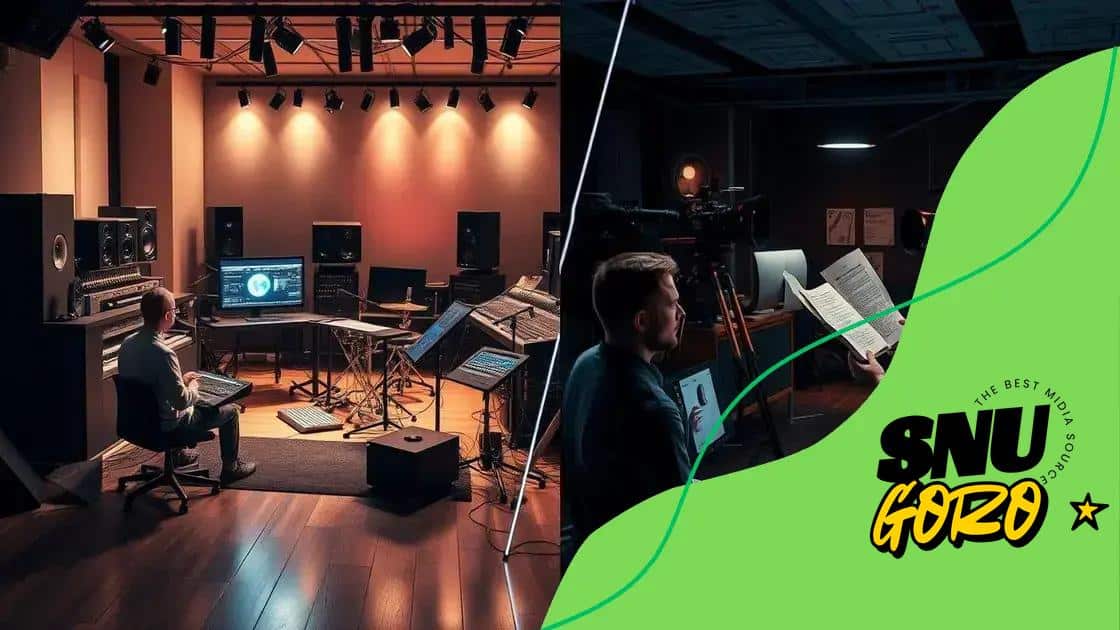The role of AI in transforming the creative industries

The role of AI in transforming the creative industries includes enhancing artistic expression, streamlining production processes, and fostering audience engagement, while also presenting challenges like resistance to change and ethical considerations.
The role of AI in transforming the creative industries is a captivating topic that merges technology with the arts. Have you noticed how machines are increasingly becoming collaborators with artists? Let’s delve into how this transformation unfolds.
Understanding AI’s impact on creative processes
Understanding AI’s impact on creative processes can open up new avenues for artists and creators alike. With the rapid evolution of technology, artists are finding innovative ways to incorporate AI into their work, leading to an exciting blend of creativity and technology.
Exploring AI Tools in Creative Work
AI tools are changing the way artists approach their craft. From generating ideas to automating repetitive tasks, these tools help artists focus on what they love most: creating. Today, artists are using AI to:
- Generate unique artwork based on specific parameters.
- Enhance their creative workflows with digital assistants.
- Collaborate with AI programs to improve composition and design.
This evolution not only increases productivity but also encourages artists to experiment more. As the boundaries between human creativity and machine output blur, exciting new art forms emerge.
Another significant aspect is how AI enables personalization in creative processes. Imagine music composition tools that analyze your mood and create a personalized soundtrack just for you. This type of technology is not just a novelty; it’s revolutionizing the way we experience art.
AI as a Collaborative Partner
More than just a tool, AI is becoming a collaborator. Artists are learning how to work alongside AI to create amazing pieces. This partnership can be viewed as a dialogue between the artist and the algorithm.
For instance, an artist might begin a painting, and an AI could suggest adjustments or color schemes based on thousands of historical data points. This kind of collaboration sparks a deeper inquiry into creativity: What is uniquely human versus what can be accomplished through machine learning?
Furthermore, embracing AI helps artists push beyond traditional boundaries. By using AI for creative ideation, artists can discover themes and mediums that resonate with their audience, always keeping them at the forefront of innovation.
The Future of Creativity with AI
As we look to the future, AI’s role in creative processes will only deepen. With ongoing advancements, the potential is vast. The fusion of human imagination and AI capabilities may yield unexpected art forms and experiences. One thing is certain: as artists adapt to these changes, the spectrum of what is possible in creativity will expand dramatically.
How AI enhances artistic expression
How AI enhances artistic expression is a fascinating subject that showcases technology’s role in redefining creativity. Artists are discovering innovative ways to collaborate with AI, unlocking new forms of expression.
The Role of AI in Creating Art
AI technologies enable artists to push their creative boundaries. By utilizing algorithms, artists can explore new styles, colors, and compositions faster than ever before. For example, AI can analyze existing artworks and generate entirely new pieces, offering artists a fresh perspective.
- AI systems can create paintings based on specific themes or emotions.
- Artists can use AI to simulate various artistic styles for their work.
- This technology allows for mixing traditional techniques with digital processes, creating unique outcomes.
As artists integrate AI into their workflow, they find themselves less restricted by traditional tools. Instead of laboriously sketching or painting, they can focus on conceptualizing and refining their ideas.
Through AI, artists can also experiment with sound, movement, and interactive installations. For instance, musicians are using AI to compose original tracks by analyzing music theory and harmony, resulting in unprecedented sound combinations.
Personalized Artistic Feedback
AI can provide artists with personalized feedback, enabling them to refine their craft. Through machine learning, AI analyzes an artist’s previous works and suggests improvements or variations. This immediate input helps artists make timely revisions.
Additionally, using AI for feedback encourages a culture of exploration. Instead of fearing criticism, artists can leverage AI insights to expand their creative horizons. By nurturing this mindset, artists see the possibilities of collaboration with technology, enriching their expression.
As AI continues to enhance artistic expression, the future looks promising. With ongoing advancements, we may witness even richer collaborations and creations that blend human intuition with machine learning capabilities.
The role of AI in music and film production

The role of AI in music and film production is transforming the entertainment industry in remarkable ways. Artists and producers are leveraging AI tools to enhance creativity and streamline processes.
AI in Music Production
In music, AI helps create new sounds and compositions. Musicians can use AI algorithms to generate original melodies or sounds that push creative boundaries. For example, AI-driven software can analyze music trends, suggesting styles and elements that resonate well with audiences.
- AI can compose background scores and enhance soundtracks.
- Tools like AIVA allow users to create original music quickly.
- AI is also used to analyze and optimize songs before release.
This technology not only saves time but also inspires musicians to explore different genres. By collaborating with AI, musicians can focus more on their artistic vision rather than the technical aspects of production.
As AI continues to evolve, we see the emergence of personalized music experiences. AI tools can create tailored playlists based on user preferences, ensuring that listeners enjoy a unique auditory journey every time.
AI in Film Production
When it comes to film production, AI offers a range of applications that enhance storytelling. From scriptwriting to post-production, AI plays a pivotal role. Filmmakers can use AI to analyze scripts, providing insights on pacing, character development, and audience engagement.
AI-driven editing software can automate tedious tasks like sorting footage and creating rough cuts. This allows editors to concentrate on the creative side of editing, adding visual effects or enhancing narratives without getting bogged down by logistics.
- AI tools like Runway and Magisto simplify video editing.
- AI can help in generating realistic visual effects and animations.
- AI algorithms analyze viewer data to enhance future productions.
By harnessing the power of AI, filmmakers can produce engaging content that resonates with audiences more effectively. This technology not only increases efficiency but also elevates the quality of creative output.
Challenges of integrating AI in creative industries
The challenges of integrating AI in creative industries are important to understand as technology evolves. While AI offers many benefits, it also presents obstacles that artists and producers must navigate.
Understanding Resistance to Change
One significant challenge is the resistance to change. Many creative professionals may feel uncertain about using AI, fearing it will replace their roles. This apprehension can lead to reluctance to explore AI tools, preventing industry advancement.
- Artists may worry that AI lacks the emotional connection present in human-created art.
- Some professionals fear losing their unique style and voice to algorithms.
- There is concern about job security as AI becomes more prevalent in production.
Such fears can stifle innovation, keeping talented creators from utilizing AI to enhance their work.
Technical Limitations and Costs
Another challenge is the technical limitations and costs associated with AI. High-quality AI tools often require a significant investment, which may be beyond the reach of some independent creators. Additionally, the learning curve for mastering these tools can be steep. Not every artist has the time or resources to acquire the necessary skills.
Creatives face challenges like:
- Understanding how to effectively use AI tools in their workflow.
- Accessing affordable software and hardware capabilities.
- Ensuring that AI-generated outputs meet their artistic standards.
As technology continues to advance, ongoing training and support will be essential to mitigate these challenges.
The Ethical Considerations
The ethical implications of using AI also present challenges. Questions about originality and ownership arise when artists incorporate AI into their work. For instance, if AI generates a piece based on an artist’s input, who owns the copyright? This dilemma can create legal uncertainty for creators.
Moreover, the potential for AI to perpetuate biases present in training data raises further ethical considerations. Artists have to remain mindful of these issues to ensure their work reflects their values.
Future trends of AI in art and creativity
Future trends of AI in art and creativity promise to reshape how artists create and engage with their audiences. As technology rapidly advances, we can expect exciting developments that make art more accessible and interactive.
Enhanced Creative Tools
One major trend is the development of enhanced creative tools that utilize AI to aid artists in their work. These tools will likely become more sophisticated, offering features that personalize the creative process. Artists can expect AI software that learns their unique styles and preferences, providing tailored suggestions for their projects.
- AI will help to automate tedious tasks, freeing artists to focus on concept and execution.
- Collaboration between humans and AI will produce new hybrid forms of art.
- Tools may offer real-time feedback on pieces, enabling artists to adjust their work instantly.
Such advancements will not only streamline the creative process but also encourage artists to experiment with new techniques and mediums.
Interactivity and Audience Engagement
Another trend is the increasing interactivity of art experiences. AI can create immersive environments where audiences participate in the art. For example, installations that adapt based on viewer input or preferences can provide personalized experiences, making art more engaging.
AI-driven platforms can analyze audience reactions, allowing artists to tailor their work to evoke specific emotions or responses. This shift to interactive art can lead to deeper connections between creators and their audiences, fostering meaningful dialogues.
Ethical and Cultural Considerations
As AI continues to evolve in the realm of creativity, ethical considerations will also become increasingly important. Future discussions will likely center around authorship, copyright, and the cultural implications of AI-generated art. Artists and technologists must collaborate to address these issues and ensure that AI complements rather than diminishes artistic expression.
Collaboration and open discourse on these challenges will help create a balanced future where technology and creativity coexist harmoniously, pushing the boundaries of what art can be.
In conclusion, the integration of AI in the creative industries is reshaping how we think about art and creativity. As we’ve explored, AI offers exciting tools that enhance artistic expression, streamline production, and foster engagement between artists and audiences. However, challenges remain, including resistance to change, technical limitations, and ethical considerations. By understanding these dynamics, we can embrace the future of creativity, where technology and human imagination coalesce to create extraordinary experiences.
FAQ – Frequently Asked Questions about AI in Creative Industries
How does AI enhance creativity in the arts?
AI provides artists with new tools and techniques that streamline workflows, allowing them to focus more on their creative vision and explore innovative styles.
What are some challenges of integrating AI into creative processes?
Challenges include resistance to change, technical limitations, and ethical concerns regarding ownership and copyright in AI-generated works.
What future trends can we expect from AI in art and music?
Future trends include more interactive art experiences and the development of tools that personalize art based on audience preferences.
Can AI replace human artists?
While AI can assist in the creative process, it is unlikely to fully replace human artists, as creativity often involves emotional depth and personal expression.





